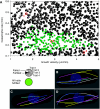Force- and length-dependent catastrophe activities explain interphase microtubule organization in fission yeast
- PMID: 19293826
- PMCID: PMC2671915
- DOI: 10.1038/msb.2008.76
Force- and length-dependent catastrophe activities explain interphase microtubule organization in fission yeast
Abstract
The cytoskeleton is essential for the maintenance of cell morphology in eukaryotes. In fission yeast, for example, polarized growth sites are organized by actin, whereas microtubules (MTs) acting upstream control where growth occurs. Growth is limited to the cell poles when MTs undergo catastrophes there and not elsewhere on the cortex. Here, we report that the modulation of MT dynamics by forces as observed in vitro can quantitatively explain the localization of MT catastrophes in Schizosaccharomyces pombe. However, we found that it is necessary to add length-dependent catastrophe rates to make the model fully consistent with other previously measured traits of MTs. We explain the measured statistical distribution of MT-cortex contact times and re-examine the curling behavior of MTs in unbranched straight tea1Delta cells. Importantly, the model demonstrates that MTs together with associated proteins such as depolymerizing kinesins are, in principle, sufficient to mark the cell poles.
Conflict of interest statement
The authors declare that they have no conflict of interest.
Figures



Comment in
-
Toward a comprehensive and quantitative understanding of intracellular microtubule organization.Mol Syst Biol. 2009;5:251. doi: 10.1038/msb.2009.7. Epub 2009 Mar 17. Mol Syst Biol. 2009. PMID: 19293831 Free PMC article. No abstract available.
Similar articles
-
A mechanism for nuclear positioning in fission yeast based on microtubule pushing.J Cell Biol. 2001 Apr 16;153(2):397-411. doi: 10.1083/jcb.153.2.397. J Cell Biol. 2001. PMID: 11309419 Free PMC article.
-
Chapter 20: Automated spatial mapping of microtubule catastrophe rates in fission yeast.Methods Cell Biol. 2008;89:521-38. doi: 10.1016/S0091-679X(08)00620-1. Methods Cell Biol. 2008. PMID: 19118689
-
Effects of {gamma}-tubulin complex proteins on microtubule nucleation and catastrophe in fission yeast.Mol Biol Cell. 2005 Jun;16(6):2719-33. doi: 10.1091/mbc.e04-08-0676. Epub 2005 Mar 16. Mol Biol Cell. 2005. PMID: 15772152 Free PMC article.
-
Force- and kinesin-8-dependent effects in the spatial regulation of fission yeast microtubule dynamics.Mol Syst Biol. 2009;5:250. doi: 10.1038/msb.2009.5. Epub 2009 Mar 17. Mol Syst Biol. 2009. PMID: 19293830 Free PMC article.
-
How Essential Kinesin-5 Becomes Non-Essential in Fission Yeast: Force Balance and Microtubule Dynamics Matter.Cells. 2020 May 7;9(5):1154. doi: 10.3390/cells9051154. Cells. 2020. PMID: 32392819 Free PMC article. Review.
Cited by
-
Contribution of actin filaments and microtubules to cell elongation and alignment depends on the grating depth of microgratings.J Nanobiotechnology. 2016 Apr 29;14(1):35. doi: 10.1186/s12951-016-0187-8. J Nanobiotechnology. 2016. PMID: 27129379 Free PMC article.
-
Symmetry, stability, and reversibility properties of idealized confined microtubule cytoskeletons.Biophys J. 2010 Nov 3;99(9):2831-40. doi: 10.1016/j.bpj.2010.09.017. Biophys J. 2010. PMID: 21044580 Free PMC article.
-
Microtubule polymerization generates microtentacles important in circulating tumor cell invasion.Biophys J. 2025 Jul 1;124(13):2161-2175. doi: 10.1016/j.bpj.2025.05.018. Epub 2025 May 26. Biophys J. 2025. PMID: 40432209 Free PMC article.
-
Effects of dynein on microtubule mechanics and centrosome positioning.Mol Biol Cell. 2011 Dec;22(24):4834-41. doi: 10.1091/mbc.E11-07-0611. Epub 2011 Oct 19. Mol Biol Cell. 2011. PMID: 22013075 Free PMC article.
-
Cytoskeletal dynamics in fission yeast: a review of models for polarization and division.HFSP J. 2010 Jun;4(3-4):122-30. doi: 10.2976/1.3385659. Epub 2010 Apr 15. HFSP J. 2010. PMID: 21119765 Free PMC article.
References
-
- Brunner D, Nurse P (2000) CLIP170-like tip1p spatially organizes microtubular dynamics in fission yeast. Cell 102: 695–704 - PubMed
-
- Carazo-Salas RE, Nurse P (2006) Self-organization of interphase microtubule arrays in fission yeast. Nat Cell Biol 8: 1102–1107 - PubMed
-
- Csikasz-Nagy A, Gyorffy B, Alt W, Tyson JJ, Novak B (2008) Spatial controls for growth zone formation during the fission yeast cell cycle. Yeast 25: 59–69 - PubMed
Publication types
MeSH terms
Substances
LinkOut - more resources
Full Text Sources

